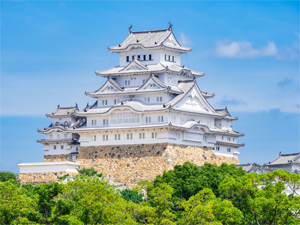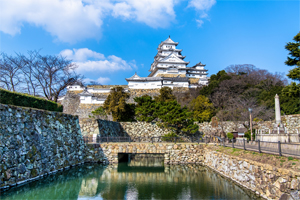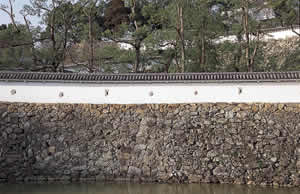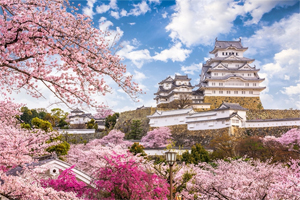

Himeji Castle: An Elegant Fortress
|
Among the numerous castles found in Japan, Himeji Castle in Hyogo Prefecture stands out with its stark white appearance that looks like a soaring white heron, thus earning the name “White Heron Castle”. It is not only recognised as a Japanese National Treasure, but it is also one of the first sites in Japan to be registered as a UNESCO World Heritage Site in 1993. The castle was completed in its present form in 1609, with its construction taking around eight to nine years. Miraculously, the building was not destroyed by war, or natural disasters like earthquakes and fire throughout the years. Thus, Himeji Castle is one of Japan’s 12 remaining original castles, and perhaps even considered to be the best preserved one.
Keeping in mind that a castle’s most important function is to ward off enemies, many of Himeji Castle’s characteristics can be tied back to practicality. For example, the thick, white plaster on the walls provide resistance to fire and bullets. In terms of location, the castle strategically lies to the west of Kyoto, the former capital city of Japan. There are three main types of castles in term of topography: built on top a mountain and utilising steep slopes for defence, built in a plain, and built on a hill in a plain. Himeji Castle belongs to the last category. There is also a system of moats surrounding Himeji Castle. Similar to other castles, the upper part of its stone foundation walls curve outwards, making it difficult for enemies to climb. The grounds of Himeji Castle are like a maze, with over 80 buildings connected by winding paths and some paths branching off into dead ends. The labyrinth-like structure is meant to confuse enemies, giving the impression that you are heading in the wrong direction even if you are getting closer. Meanwhile, the variety of openings in the walls expose the enemy and allows one to defend and slow down enemy invasion. The thin rectangular openings were meant for arrows, while the round or square holes were meant for muskets. There are also other openings meant for dropping stones. All of these contribute to the goal of preventing enemy access to the tallest watchtower and the castle keep. Upon climbing to the top of the six-storey main keep, one can find a small shrine. Visitors can look out in all directions and look down upon the castle’s complex structure, as well as Himeji City. You may also spot the fish shaped roof ornaments, shachihoko, which are said to protect the castle from fire. Spring is easily the most popular time to visit the castle grounds, as there are over 1,000 cherry blossom trees. Many visitors would picnic under the beautiful flowers, that usually bloom in early April. Nonetheless, if you wish to avoid the crowd, visiting Himeji Castle during other times of the year does not take away its elegance. |
 © Japan Up Close  © Japan Up Close  © Moritake Takashi  © Japan Up Close |
Resources
|
Sakagami, Kyoko. 2001. “Himeji Castle, a World Heritage Site”. NIPPONIA. https://web-japan.org/nipponia/nipponia17/en/feature/feature03.html. “A Tour of Japanese Castles”. 2012. Kids Web Japan. Accessed 21 May. https://web-japan.org/kidsweb/travel/castles/castles04.html. “Himeji Castle”. 2024. japan-guide.com. Accessed 21 May. https://www.japan-guide.com/e/e3501.html. “Himeji Castle”. 2024. Japan National Tourism Organization. Accessed 21 May. https://www.japan.travel/en/spot/1030/. “Himeji Castle (UNESCO)”. 2024. Japan National Tourism Organization. Accessed 21 May. https://www.japan.travel/en/world-heritage/himeji-jo-castle/. |
|
Japan Creative Centre 4 Nassim Road, Singapore 258372 +65 6737 0434 / jcc@sn.mofa.go.jp https://www.sg.emb-japan.go.jp/JCC/ Nearest parking at Orchard Hotel & Delphi Orchard |
 |